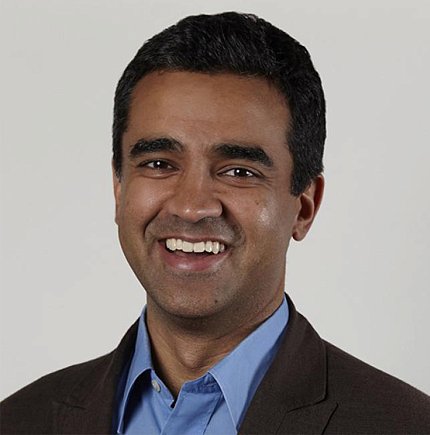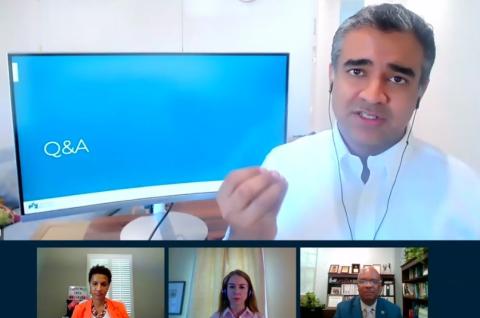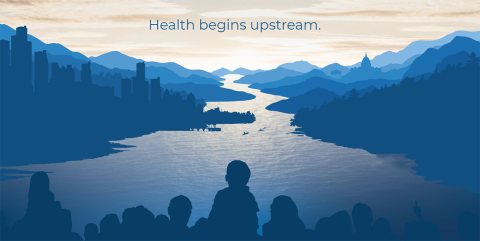moving upstream
Manchanda Makes the Case for Whole Person Care, Equity

Doctors are trained to examine the biological causes of illness and many delve into personal habits and other behavioral factors for a more complete health profile. Health professionals, though, often overlook a key component of well-being, said Dr. Rishi Manchanda, a physician, entrepreneur and public health leader whose work experience has led him to speak out about this vital aspect of whole person care.
Health care institutions, he said, must also address the social and structural drivers of health equity for patients and the communities they serve. Getting the fullest picture of health to provide the best care requires understanding patients’ social needs and looking at the broader social and structural environment—where people eat, sleep, work and play, said Manchanda.
He has seen the need, having worked with low-income families, homeless veterans and rural immigrants. Currently, Manchanda is president and CEO of HealthBegins, a firm that helps health care and community partners address social and structural barriers to health equity.
“The needs are greatest in communities that have been historically marginalized due to structural racism and economic inequity,” he said at a recent virtual Deputy Director for Management seminar.
And it’s pervasive. Too many people are drowning in financial, food and/or housing insecurity.

Meet Mrs. M, a middle-aged widow with two young children. She works 2 low-wage jobs, 1 of which has a health plan. She spends $2,600 annually on health premiums and out-of-pocket costs.
In March, Mrs. M was rushed to the ER after coworkers found her listless. Tests confirmed hypoglycemia. It wasn’t a rare episode. Mrs. M has type 2 diabetes and has had trouble keeping her blood sugar stable. Doctors search for what’s causing her low blood sugar, but the problem is systemic.
“At that bedside, in that health care system, more likely in that community, we don’t really apply the same level of rigor [as we do with biological or behavioral issues] when it comes to evaluating—with precision and with efficacy—the social factors that drive poor and inequitable outcomes,” Manchanda said. “I would argue from experience: the failure to do so is tantamount to providing sub-standard care.” And that inferior care is disproportionately experienced by marginalized populations.
Research shows that lower-income diabetic adults like Mrs. M have an almost 30 percent higher rate of hospital admissions at the end of the month due to food insecurity compared to higher-income adult diabetics, said Manchanda. Before the pandemic, 1 in 8 Americans reported food insecurity; now, millions more lack access to enough food.
Manchanda explained that Mrs. M lives in a food desert that exists “because of policy and political choices we’ve all made as a society.” Redlining, which dates back almost a century, “still ripples through the decisions and the zoning issues, not just for housing and banking, but also for other policies, including access to food.”

A new strategy is needed to turn the tide. Manchanda suggests an “upstreamist” approach, described by an old parable he adapted and retells to new practitioners.
Three friends are relaxing by the river when suddenly they spot people drowning. All three jump in to help.
The first friend jumps in to rescue people struggling in the water. The second goes farther upstream and grabs branches to build a raft so she can usher even more people to safety. The rescuer and the raft-builder play vital roles in saving people, but each day at the river, they find themselves rescuing the same people, said Manchanda. They’re committed but getting fatigued and frustrated; implicit biases start surfacing.
Meanwhile, the third friend—“the upstreamist”—swims even farther upstream, to find out what’s causing these people to fall in the water. The story offers a profound lesson for anyone involved in health care, Manchanda emphasized, and the moral and business case for moving upstream is getting stronger every day.
“Improving the social and structural drivers of health equity is not an academic pursuit primarily,” he said. “It’s a practice, a part of what it means to deliver the highest standard of care for patients and uphold the highest standards of institutional responsibility to our communities.”

So, the question looms: how can health care institutions integrate and advance the social and structural drivers of health equity at scale?
The transformation, he said, needs to happen at all levels—individual, community and societal. For institutions to drive this transformation, Manchanda created a formula to describe what needs to be in place: E=AMC2. To advance equity, he said, requires accountability, motivation, workforce competencies and system capabilities.
Accountability has several integral components, he said. Meaningful change can only come about if there are ways for people from marginalized communities to participate in institutional oversight. There also must be mechanisms for transparency, answerability, institutional redress for past harms and consequences for persistent shortfalls in the pursuit of equity.
Manchanda called NIH’s UNITE “a model of what it looks like to build institutional transparency.” Once health care institutions identify inequities among patients and employees, he said, the data must be made public and the rationale for how to address inequities should be explained and made available for public scrutiny.
As someone who has built clinics and helped design and lead health equity interventions in marginalized communities, Manchanda underscores addressing unmet needs, most of which tend to be social, not medical. In one case, he converted a health center into a medical-legal clinic where a public interest lawyer was the main attraction.
“When you address social and legal needs explicitly through an equity lens, you unlock possibilities to also improve health care access and other important measures of clinical quality and population management,” he said. That integrated health-social care model stabilized lives and greatly reduced ER visits, while improving care satisfaction and reducing patient-level and systemic inequities.
“We’re in a moment right now where many institutions across the country have committed publicly to addressing structural racism, to identifying racism as a public health crisis, to addressing social and structural drivers of health equity—to moving upstream,” said Manchanda. “We’re in a moment where I hope we can take the next step…to start to really interrogate the degree to which we’re doing this work well.”
NIH'ers can view upcoming and archived DDM seminars (while on VPN) by visiting http://ddmseries.od.nih.gov/.
